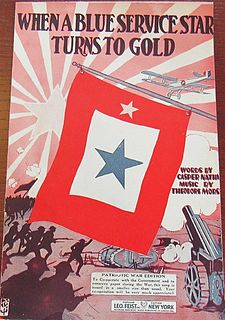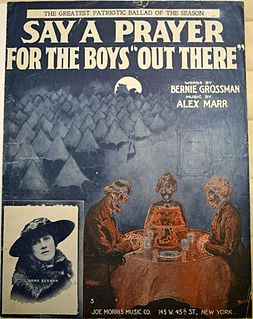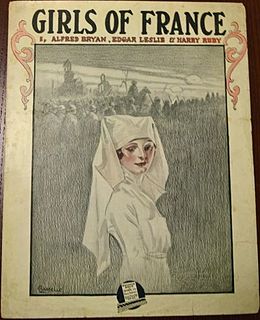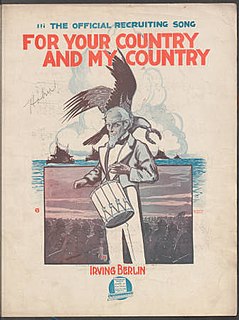
"My Country, 'Tis of Thee", also known as "America", is an American patriotic song, whose lyrics were written by Samuel Francis Smith. The melody used is the same as that of the national anthem of the United Kingdom, "God Save the Queen", arranged by Thomas Arne. The song served as one of the de facto national anthems of the United States before the adoption of "The Star-Spangled Banner" as the official U.S. national anthem in 1931.

The "Battle Hymn of the Republic", also known as "Mine Eyes Have Seen the Glory" outside of the United States, is a lyric by the American writer Julia Ward Howe using the music from the song "John Brown's Body". Howe's more famous lyrics were written in November 1861 and first published in The Atlantic Monthly in February 1862. The song links the judgment of the wicked at the end of the age with the American Civil War. Since that time, it has become an extremely popular and well-known American patriotic song.

Guy Hughes Carawan, Jr. was an American folk musician and musicologist. He served as music director and song leader for the Highlander Research and Education Center in New Market, Tennessee.

The "Battle Cry of Freedom", also known as "Rally 'Round the Flag", is a song written in 1862 by American composer George Frederick Root (1820–1895) during the American Civil War. A patriotic song advocating the causes of Unionism and abolitionism, it became so popular that composer H. L. Schreiner and lyricist W. H. Barnes adapted it for the Confederacy.

"The Bonnie Blue Flag", also known as "We Are a Band of Brothers", is an 1861 marching song associated with the Confederate States of America. The words were written by the entertainer Harry McCarthy, with the melody taken from the song "The Irish Jaunting Car". The song's title refers to the unofficial first flag of the Confederacy, the Bonnie Blue Flag. The left flag on the sheet-music to the reader's right is the Bonnie Blue Flag.

During the American Civil War, music played a prominent role on both sides of the conflict: Union and Confederate. On the American Civil War battlefield, different instruments including bugles, drums, and fifes were played to issue marching orders or sometimes simply to boost the morale of one's fellow soldiers. Singing was also employed not only as a recreational activity but as a release from the inevitable tensions that come with fighting in a war, particularly a war in which the issue of freedom of a race is to be decided. In camp, music was a diversion away from the bloodshed, helping the soldiers deal with homesickness and boredom. Soldiers of both sides often engaged in recreation with musical instruments, and when the opposing armies were near each other, sometimes the bands from both sides of the conflict played against each other on the night before a battle.

Heart of Wetona is a World War I era song released in 1919 by Leo Feist, Inc. of New York, New York. Sidney D. Mitchell wrote the lyrics. Archie Gottler composed the music. Rosenbaum Studios provided the cover art. On the cover is a soldier embracing a Native American woman. In the background is a Native American on horseback, holding a spear above his head. Featured in the center is a picture of American silent film actress, Norma Talmadge, who starred in the film The Heart of Wetona (1919), whom the song is dedicated to. The song was written for both voice and piano.

Our Country's in It Now! is a World War I era song released in 1918. Arthur Guy Empey wrote the lyrics. Charles R. McCarron and Carey Morgan composed the music. The song was published by Jos. W. Stern & Co. of New York, New York. On the cover, on both the left and right side, are drawings of soldiers engaged in trench warfare. In the center is a photograph of Arthur Guy Empey dressed in uniform. It is written for voice and piano.

"Say, You Haven't Sacrificed at All! (March)", also written as "Say-You Haven't Sacrificed at All!" or "Say-You Have-n't Sacrificed at All!", is a World War I era song released in 1918. Most sources have attributed the role of composer to Will E. Dulmage and lyricist to J. Fred Lawton, as it is credited on the sheet music cover. One source has their roles reversed, and another source claims both composed the music. The song was published by Chas E. Roat Music Co. of Battle Creek, Michigan. On the cover is a soldier with a head wound, pointing. Behind him are British, French, and American flags. It was written for both voice and piano.

"Cheer Up, Mother" is a World War I era song released in 1918. Mary Earl composed the music and wrote the lyrics. Shapiro, Bernstein & Co. of New York, New York published the song. Artist Albert Wilfred Barbelle designed the sheet music cover. It features a mother saying good-bye to her soldier son. It was written for both voice and piano.

"You Great Big Handsome Marine" is a World War I era song released in 1918. Most sources solely credit Harold Dixon as both the composer and lyricist, as it is listed on the sheet music. Other sources give composer credit to Dixon and lyricist credit to I. Chapman. The song was published by Dixon-Lane Publishers of St. Louis, Missouri. On the cover is a soldier standing at attention. A battleship is behind him, and planes are flying overhead. The song was written for both voice and piano.

"When a Blue Service Star Turns to Gold" is a World War I era song released in 1918. Caspar Nathan wrote the lyrics. Theodore Morse composed the music. Leo Feist, Inc. of New York, New York published the song. Featured prominently on the sheet music cover is a service star. Beneath it are soldiers charging with artillery, a tank, and a plane. It was written for both voice and piano.

"Gee! What a Wonderful Time We'll Have When the Boys Come Home" is a World War I era song released in 1917. Lyrics and music were written by Mary Earl. The song was published by Shapiro, Bernstein & Co. of New York, New York. It was written for both voice and piano. The sheet music cover was designed by artist Albert Wilfred Barbelle. On the cover are soldiers marching down a city street. A skyline is behind them, and the lights spell out, "Welcome Home."

"The Little Grey Mother Who Waits All Alone " is a World War I era song released in 1915. Bernard Grossman wrote the lyrics. Harry De Costa composed the music. The song was published by M. Witmark & Sons of New York, New York. Vitagraph actress Mary Maurice is featured on the cover, reading a book and holding a rose. It was written for voice and piano.

"Say a Prayer for the Boys "Out There"" is a World War I era song released in 1917. Bernie Grossman wrote the lyrics. Alex Marr composed the music. It was published by Joe Morris Music, Co. of New York, New York. The sheet music cover was designed by the Starmer Brothers. It features a family praying at the dinner table. Behind them is a sentry guarding a campground of tents. There is an inset photo on the left side that varies per edition. The song was written for both voice and piano.

"Girls of France" is a World War I era song released in 1917. Al Bryan and Edgar Leslie wrote the lyrics. Harry Ruby composed the music. The song was published by Waterson, Berlin & Snyder Co. of New York, New York. Artist Albert Wilfred Barbelle designed the sheet music cover. It features a nurse in the foreground, and soldiers marching behind her. It was written for both voice and piano.

"Don't Let Us Sing Anymore About War, Just Let Us Sing of Love " is a World War I era song released in 1918. Lyrics and music were written by Harry Lauder. It was published by T.B. Harms and Francis, Day & Hunter, Music Co. of New York, New York. The sheet music cover features a photo of Lauder with his autograph. The song was written for both voice and piano.

"The Ragtime Soldier Man" is a World War I era song released in 1912 and 1917. Irving Berlin wrote the lyrics and composed the music. The song was published by Waterson, Berlin & Snyder, Co. of New York, New York. Artist Pfeiffer designed the sheet music cover. It features a U.S. soldier holding his rifle and jumping over cannon balls. The song was written for voice and piano.

"For Your Country and My Country" is a World War I era song released in 1917. Lyrics and music were written by Irving Berlin. The song was published by Waterson, Berlin & Snyder, Co. of New York, New York. Artist Albert Wilfred Barbelle designed the sheet music cover. It features Uncle Sam playing a snare drum with an eagle on his shoulder. In the background are ships sailing, and below are troops marching. Above the title, it reads, "The Official Recruiting Song." The song was written for voice and piano, along with chords for guitar, ukulele, and banjo.






















